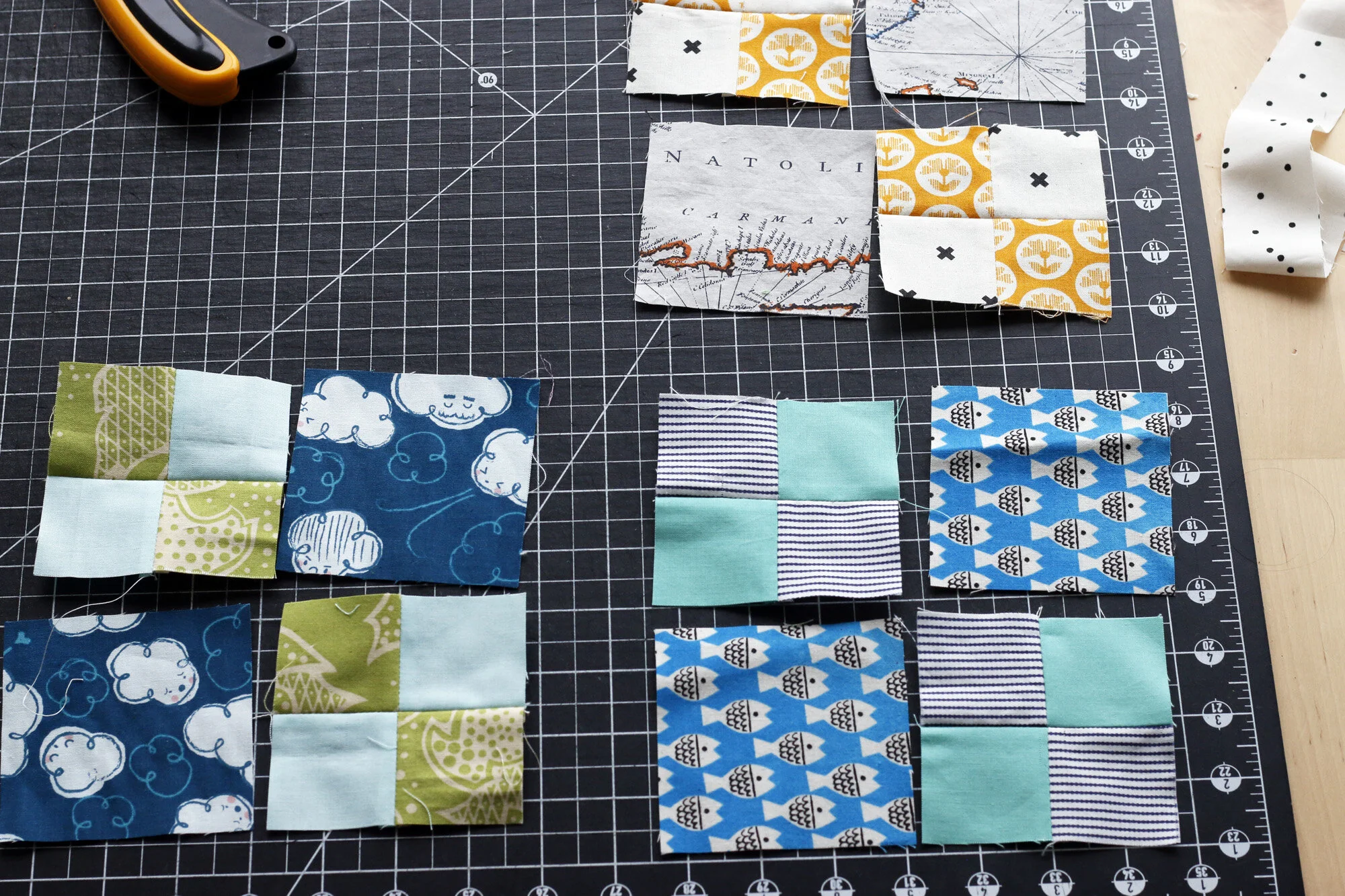Penny Patch: Cutting
This post is part of a series Penny Patch: a Beginner’s Quilt-Along, circa 2013. Please see this page for links to all posts.
Woohoo, cutting! This post contains a ton of pictures aimed to help beginners. Don’t need so much help? Scroll to the Cutting Summary at the end of this post!
Get out those fat quarters and press them. If you're not sure how many fat quarters you should have for your quilt, see the Nitty Gritty section of Color Scheme ideas.
Step 1: Sort Colors
Group your fat quarters into color piles:
A = Main color
B = Main color. Used slightly more than color A.
C = Pop color. It will appear in small flashes in the quilt.
Low Volume = Fabrics much lighter in color than the others , which may feel neutral or "pale".
N = Mid-value neutrals (not for Baby quilt). These are not as light as your low-volumes, but still neutral. N adds depth to the quilt.
Step 2: Cut the Straight Edge
Place your cutting mat towards a corner of your work table so that you can approach the mat from two sides. Never used a rotary cutter before? Please see rotary cutting 101.
Begin by placing your pressed fabric on the cutting mat. Orient it as shown with the 22" side horizontal and the 18" side vertical. Throughout the cutting directions, the fat quarter is always oriented in this way. Your fat quarter may actually be slightly smaller if it was prewashed. No worries! We have extra fabric "wiggle room" in this cutting plan, even if your fabric is pre-shrunk.

I am right handed. If you are left-handed, you will be cutting with your left hand and will have to mirror what I am demonstrating.
In cutting EACH fat quarter, the first step is to create two nicely trimmed edges. To do so, slide the fabric until the bottom raw edge extends just beyond a horizontal cutting mat line and the right raw edge just beyond a vertical line. In this case, my selvedge is at right, so I slide the fabric until the entire selvedge is past that vertical cutting mat line.
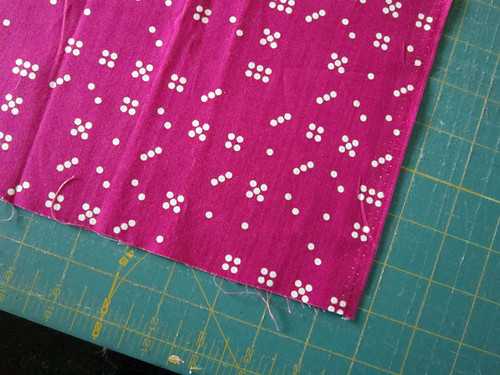
Place your quilting ruler so that its edge matches up with that vertical line. Cut, removing the selvedge and establishing a straight vertical edge.

Now place your quilting ruler horizontally, across the 22" length of the fabric, and match it up with the horizontal line just inside the fabric's raw edge.
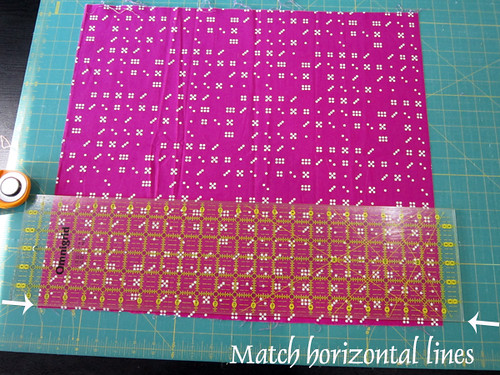
In this example the corner of my table is at my left side. I move around the corner so that I can make this horizontal cut with proper ergonomic reach. Cut, removing raw edge at the bottom of the fat quarter and creating a straight horizontal edge.
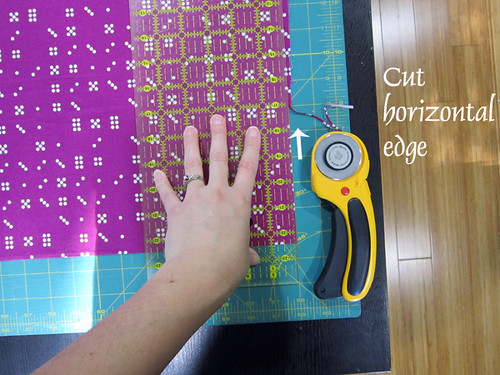
Never try to cut from an angle that feels hard to control! Always move your body or even rotate the cutting mat so that you can approach the fabric from a comfortable angle. Avoid moving the fabric itself, to increase accuracy.
Now the fat quarter has two straight edges: a vertical and a horizontal. If you are left-handed, your vertical edge will be at the left side of your fabric. Since I am right-handed, it is at the right side.
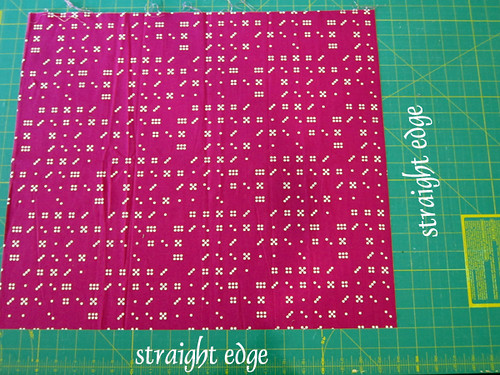
Step 3: Cut A & B fabrics
Cut 2” Strips
Begin with an A colored fabric. First cut (2) 2" strips along the bottom horizontal edge. To do so, place the ruler at a horizontal cutting mat line 2" from the bottom straight edge.
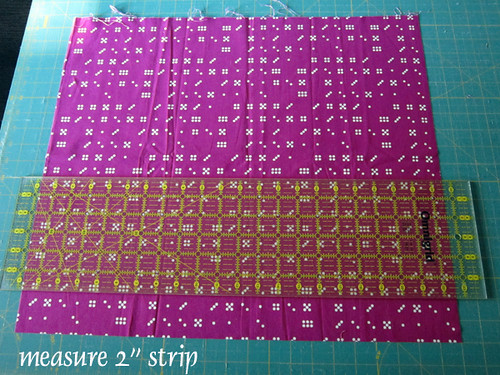
Then move around the corner to position your body ergonomically to cut.
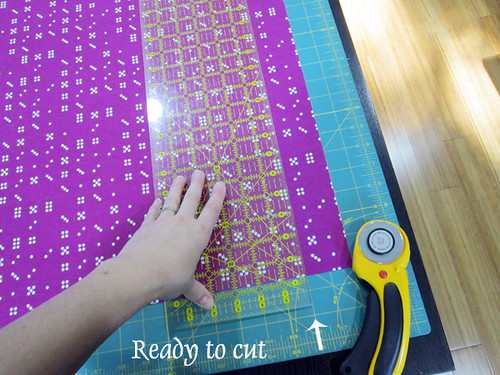
Cut the second 2" strip in the same way. Each fat quarter yields (2) 2" strips. Set them aside.

Cut 3.5” squares
Next cut a 3.5" strip measuring from the vertical straight edge.
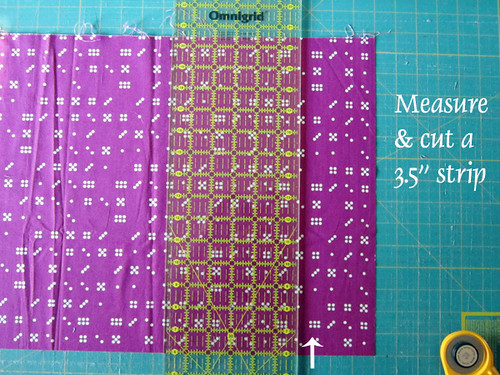
Measure and cut a second 3.5" strip. It will be a total of 7" from the vertical straight edge.
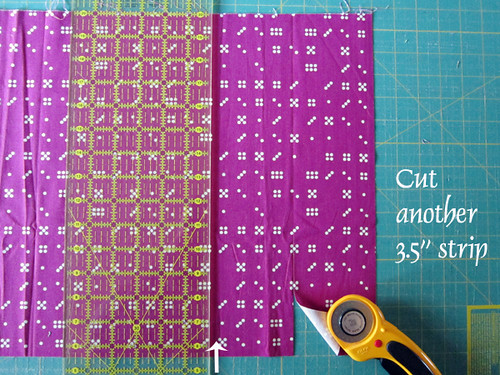
Remove excess fabric, so that only the 3.5" strips remain in your cutting area.
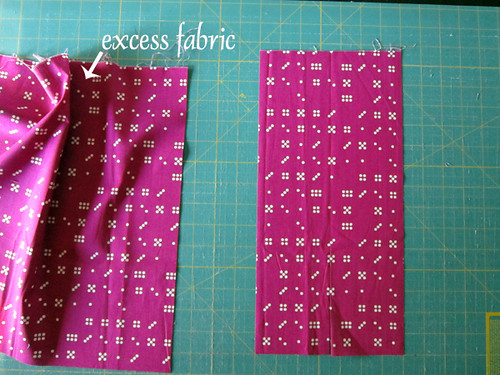
Measuring from the bottom, where you already have a straight edge, cut 3.5" fabric squares. Since the 3.5" strips are side-by-side, each cut will yield (2) 3.5" squares. You’ll need sets of two matching 3.5" squares for the Penny Patch blocks and simple 4-patch blocks.
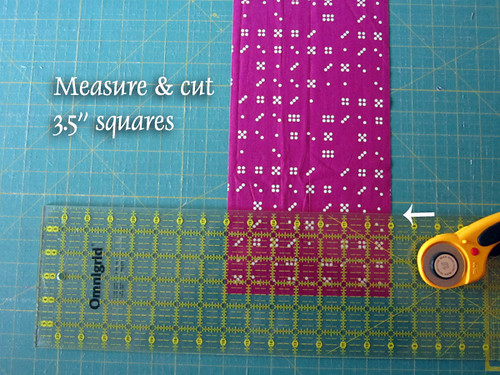
Continuing measuring and cutting at 3.5", creating more 3.5" squares.
Since this is a short cut, I am able to cut without moving around the corner of a mat. I position my hand like so. But, again, do whatever you need to do to cut from an angle that feels fully in control. Try sliding the mat or, if absolutely necessary, reposition the fabrics so that they are easier to reach.
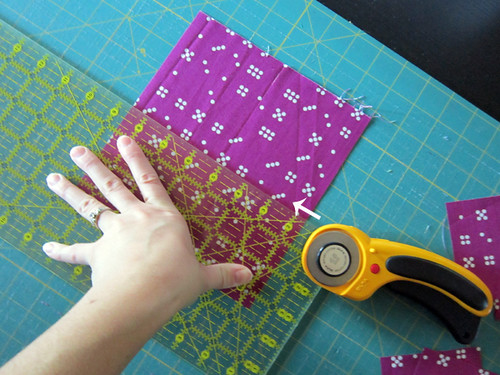
Each fat quarter will yield (6) 3.5" squares. Set aside.
Cut 6.5” squares
Return the excess fabric to the cutting mat. It measures about 14" square. Match its vertical and horizontal straight cuts to lines on your cutting mat.
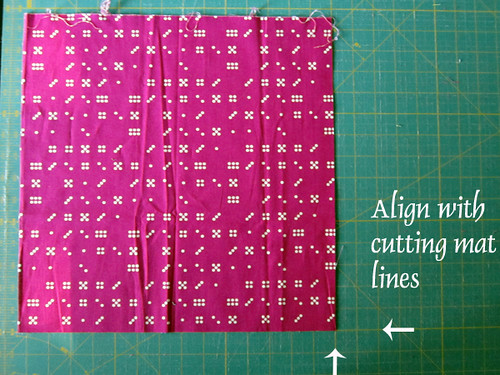
Measuring from the vertical straight edge, cut at 6.5" over.

Cut again at 6.5" over, creating two 6.5" strips. Remove narrow waste fabric at left.
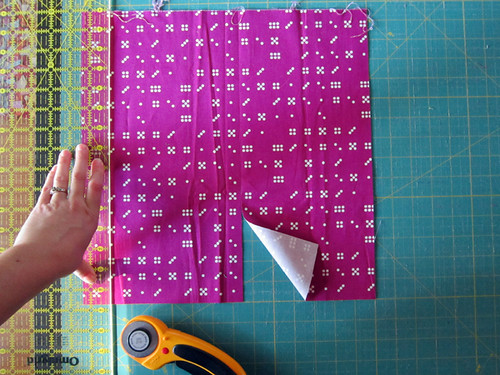
Make a horizontal cut at 6.5" from the bottom straight edge, creating (2) 6.5" squares. You may want to use the corner of the table to orient yourself for this cut, once again.
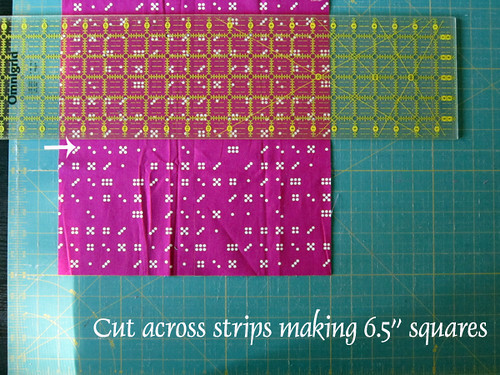
Repeat, so that each fat quarter yields (4) 6.5" squares.
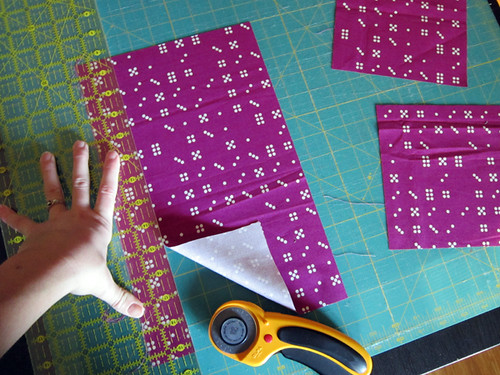
This series of cuts is Cutting Plan #1. It yields: (2) 2" x 22" strips, (6) 3.5" squares and (4) 6.5" squares.
Cut color A fat quarters via Cutting Plan #1.
With color B, cut all but one fat quarter via Cutting Plan #1. Save one color B fat quarter to be cut via Cutting Plan #2.
Note: you will NOT need all of the 2" strips and 3.5" squares generated by this cutting plan, especially in color A fabrics. To verify what you need, see the cutting summary at the end of this post. If you want to avoid cutting extra fabrics, you can start by cutting your favorite fabrics first, keep a tally, and stop cutting certain parts of this cutting plan when you reach your quota.
Step 4: Cut Color C
For baby-sized quilt: cut Color C with Cutting Plan #1. However, stop cutting after making the 3.5" squares. You do not need any 6.5" squares in color C.
For throw or twin-sized quilts: cut Color C as follows:
Cut 3.5” Squares
Start, as usual, with trimming for a vertical and horizontal straight edge (see Step 2).
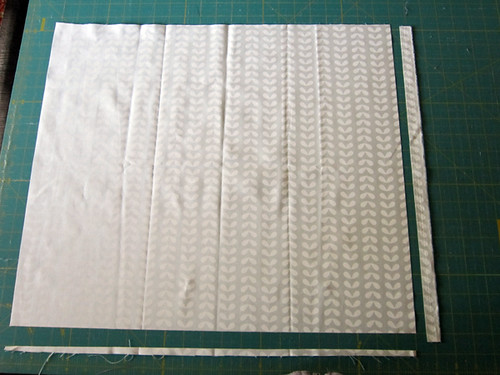
Then place your ruler at 3.5", measuring from the bottom horizontal straight edge.
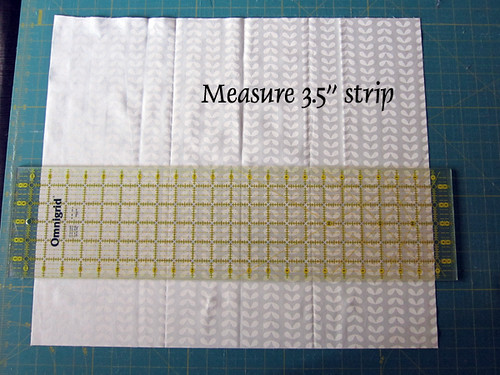
Move around the corner of your table to cut this 3.5" strip.
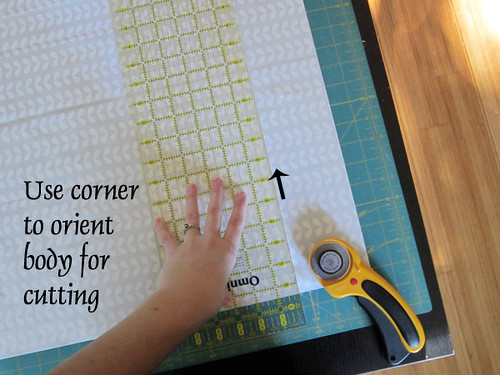
Cut a second 3.5" strip in the same way.
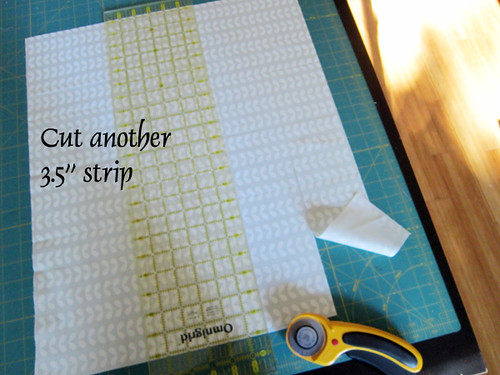
Return to the normal side of the table. Remove the excess fabric from above the 3.5" strips.
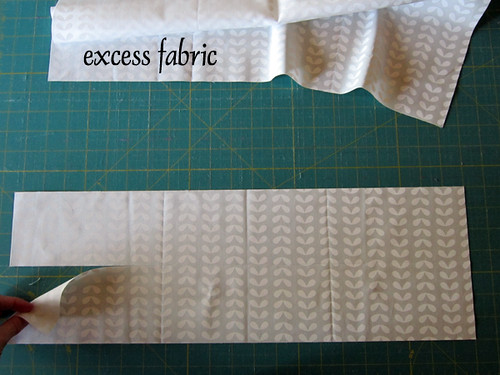
Now place your ruler at 3.5", measuring from the vertical straight edge.

Cut, creating a pair of 3.5" squares.

Move the ruler to the left 3.5" and cut again. Repeat, creating a series of 3.5" square pairs.

Cut a total of (12) 3.5" squares. Set aside.
Return the excess fabric to the cutting mat. It measures about 11" x 22". Match its vertical and horizontal straight cuts to lines on your cutting mat. Repeat the process above to cut (12) more 3.5” squares.
Cut a 2” Strip
You have just a sliver of fabric left from the original fat quarter. Measure a 2" strip from the bottom horizontal straight edge and cut. This will yield (1) 2" x 22" strips.
This series of cuts is Cutting Plan #2. It yields: (24) 3.5" squares and (1) 2" strip.
All color C fabrics can be cut in this way. However, you will NOT need all of the cuts generated by this cutting plan. To verify what you need, see the cutting summary at the end of this post. If you want to avoid cutting extra fabrics, keep a tally and stop when you reach your quota.
For all quilt sizes, cut 1 color B fat quarter with Cutting Plan #2.
Step 5: Cut Low Volumes
When cutting your low volume fat quarters, you will cut some via Cutting Plan #1 and some via Cutting Plan #2. This combination yields the ideal ratio of shapes.
for a Baby Penny Patch quilt
Cutting Plan #1 - Cut 5 fat quarters in this way
Cutting Plan #2 - Cut 2 fat quarters in this way
for a Throw Penny Patch quilt
Cutting Plan #1 - Cut 6 fat quarters in this way
Cutting Plan #2 - Cut 4 fat quarters in this way, with a caveat: You do not need all the pairs yielded by this cutting plan. After reaching the goal of (110) 3.5” squares (or 55 pairs), reserve excess fabric for additional 2” strips as needed.
for a Twin Penny Patch quilt
Cutting Plan #1 - Cut 9 fat quarters in this way
Cutting Plan #2 - Cut 5 fat quarters in this way, with a caveat: You do not need all the pairs yielded by this cutting plan. After reaching the goal of (160) 3.5” squares (or 80 pairs), reserve excess fabric for additional 2” strips as needed.
As with the other fabrics, you can consult the Cutting Summary and keep a tally as you cut if you'd like to avoid over-cutting. Notice that I do not estimate how many low volume 2" strips you'll need. Because of the flexibility in the way colors are chosen for Penny Patch blocks, needs will vary. Cut more as needed from leftover low volume fabric, when you see what fabrics you like best in your blocks.
Step 6: Cut Fabric N
Note: This step applies to throw and twin-sized Penny Patch quilts only.
Prepare your fabric by trimming a vertical and horizontal straight edge.
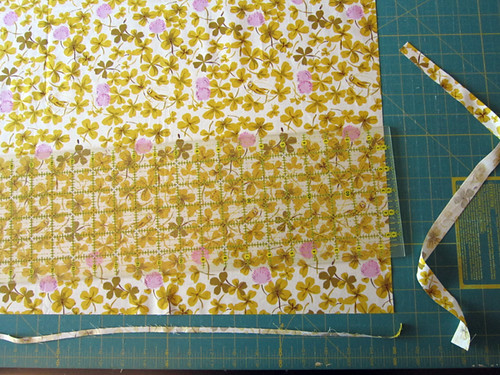
Then place your ruler at 6.5", measuring from the bottom horizontal straight edge.
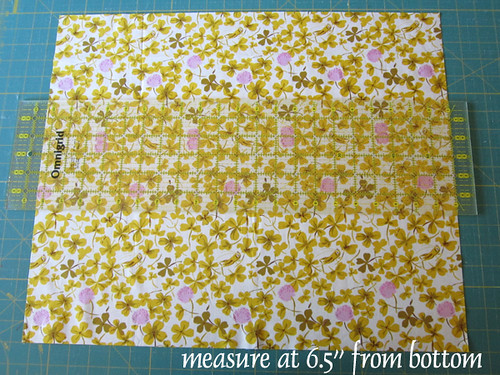
Move around the corner of your table to cut this 6.5" strip. Cut a second 6.5" strip in the same way.
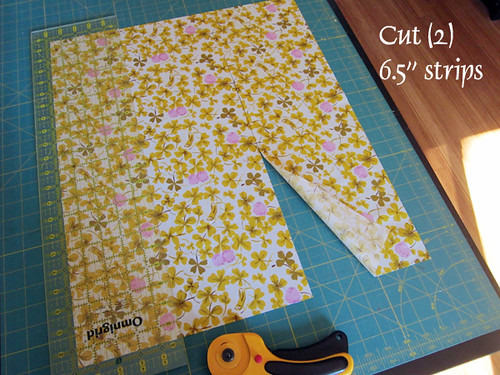
Remove the excess fabric from above the 6.5" strips. Now place your ruler at 6.5", measuring from the vertical straight edge.
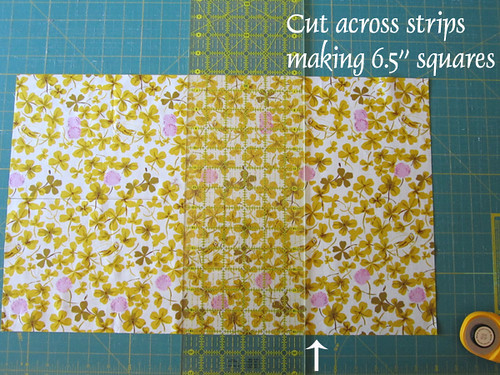
Cut, creating a pair of 6.5" squares. Move the ruler to the left 6.5" and cut again.

Repeat one more time, creating a total of (6) of 6.5" square pairs.
This Cutting Plan #3 yields (6) 6.5" squares. The throw quilt requires 6 fabric N squares, while the twin requires 8.
Cutting Summary
3.5” squares are listed below as “pairs” because two identical squares are always needed. 1 pair = a set of (2) 3.5” squares.
Via our cutting plans, 2" strips are about 22" long. Not following our cutting plan? Your strips must be at least 16" long for the Penny Patch quilt.
for a Baby Penny Patch quilt
Color A - (8) 6.5" squares, (5) pairs of 3.5" squares and (1) 2" strip
Color B - (8) 6.5" squares, (11) pairs of 3.5" squares and (2) 2" strips
Color C - (4) pairs of 3.5" squares and (1) 2" strips
Low Volume - (15) 6.5" squares, (32) pairs of 3.5" squares and assorted 2" strips
for a Throw Penny Patch quilt
Color A - (15) 6.5" squares, (8) pairs of 3.5" squares and (3) 2" strip
Color B - (15) 6.5" squares, (17) pairs of 3.5" squares and (5) 2" strips
Color C - (10) pairs of 3.5" squares and (1-2) 2" strips
Low Volume - (24) 6.5" squares, (55) pairs of 3.5" squares and assorted 2" strips
Neutral N - (6) 6.5" squares
for a Twin Penny Patch quilt
Color A - (18) 6.5" squares, (12) pairs of 3.5" squares and (4) 2" strip
Color B - (21) 6.5" squares, (25) pairs of 3.5" squares and (6) 2" strips
Color C - (14) pairs of 3.5" squares and (2) 2" strips
Low Volume - (35) 6.5" squares, (80) pairs of 3.5" squares and assorted 2" strips
Neutral N - (8) 6.5" squares









